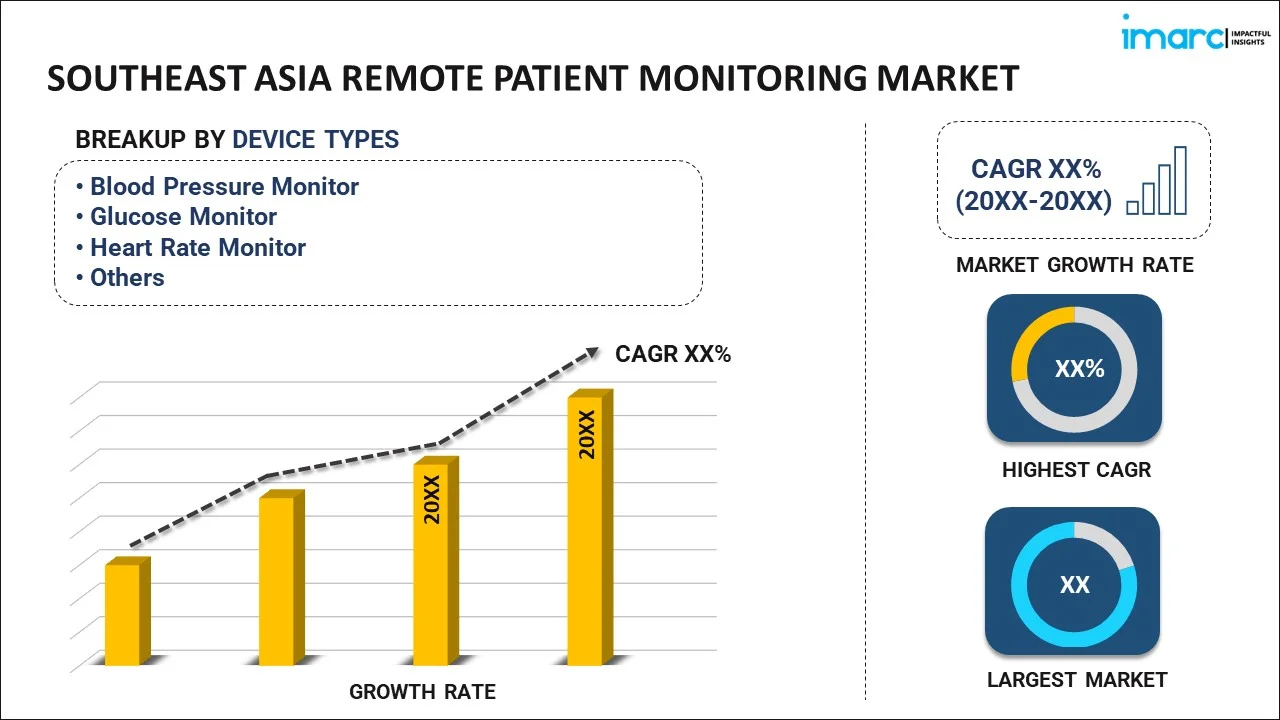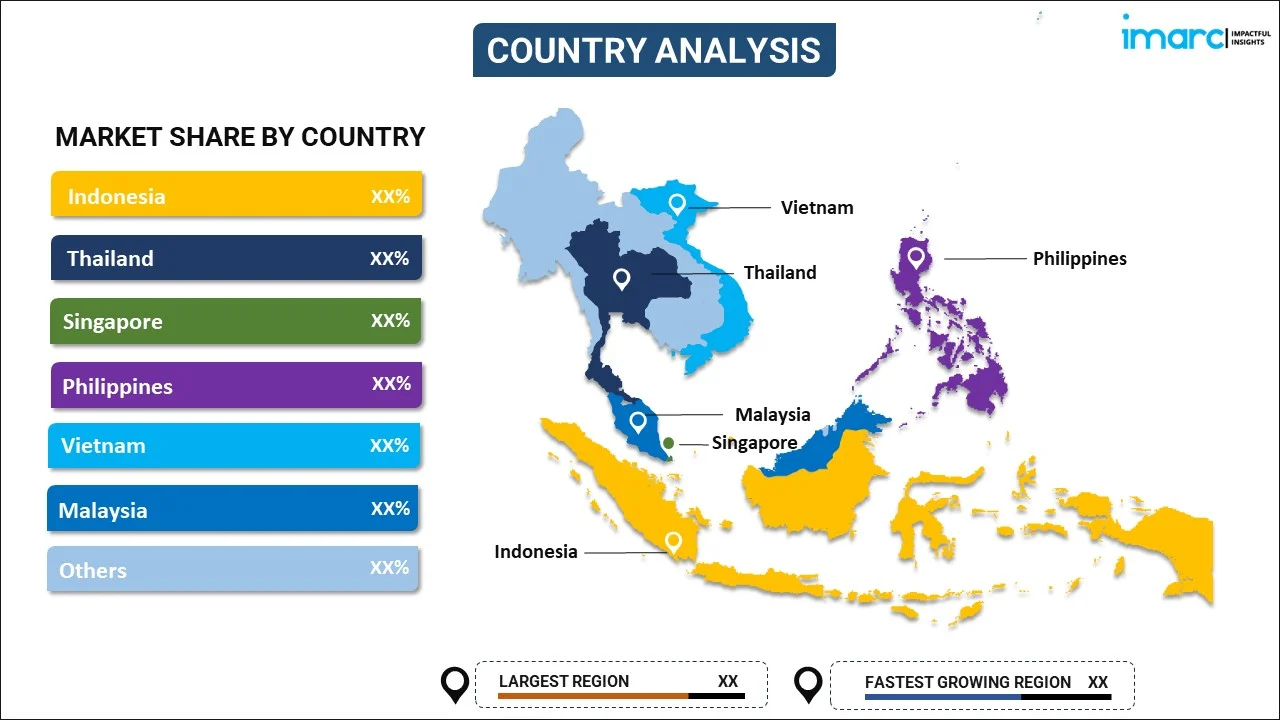
Southeast Asia Remote Patient Monitoring Market Report by Device Type (Blood Pressure Monitor, Glucose Monitor, Heart Rate Monitor, Pulse Oximeters, Respiratory Monitor, and Others), Application (Cancer Treatment, Cardiovascular Diseases Treatment and Monitoring, Diabetes Treatment, Sleep Disorder Treatment, Weight Management and Fitness Monitoring, and Others), End Use (Hospitals and Clinics, Homecare Settings, and Others), and Country 2024-2032
Market Overview:
Southeast Asia remote patient monitoring market size is projected to exhibit a growth rate (CAGR) of 28.70% during 2024-2032. The emerging trend of personalized healthcare options, where treatments and care plans are tailored to individual needs, is primarily driving the market growth.
|
Report Attribute
|
Key Statistics
|
|---|---|
|
Base Year
|
2023 |
|
Forecast Years
|
2024-2032
|
|
Historical Years
|
2018-2023
|
| Market Growth Rate (2024-2032) | 28.70% |
Remote patient monitoring (RPM), alternatively termed remote physiologic monitoring, entails the utilization of digital technologies to gather medical and health data concerning parameters such as weight, blood pressure, oxygen levels, heart rate, and electrocardiograms (ECG) from individuals situated in a single location. Subsequently, this information can be securely transmitted electronically to healthcare providers located in different geographical areas. This approach allows healthcare professionals to monitor the patient's status without the necessity of their physical presence within a healthcare facility. RPM proves particularly advantageous in the management of chronic ailments, post-operative recuperation, and the provision of care for the elderly.
Southeast Asia Remote Patient Monitoring Market Trends:
The Southeast Asia remote patient monitoring market is witnessing a notable upsurge, driven by the escalating prevalence of various chronic illnesses, including diabetes, hypertension, and cardiac disorders, alongside the expanding elderly demographic, which exhibits a higher susceptibility to severe medical conditions. Additionally, the rapid advancement of digitization, the substantial reliance on smartphones, the increasing accessibility of high-speed internet, and the rising income levels among individuals are collectively contributing to the growing demand for remote patient monitoring solutions on a global scale. Moreover, the mounting scarcity of healthcare professionals, particularly in remote regions, is accelerating the adoption of RPM as an alternative to conventional care practices, allowing limited medical staff to efficiently manage a greater number of patients. Furthermore, the growing necessity for healthcare systems to fortify their preparedness for pandemics or similar emergent situations is fostering the expansion of the market, emphasizing the critical role of remote patient monitoring in maintaining healthcare continuity during challenging times. Besides this, the escalating inclination towards mobile health (m-health) applications to offer high-quality virtual care and home-based medical services to patients through the utilization of chatbots and real-time interactions is expected to exert a positive influence on the market dynamics within Southeast Asia over the forecasted period.
Southeast Asia Remote Patient Monitoring Market Segmentation:
IMARC Group provides an analysis of the key trends in each segment of the market, along with forecasts at the regional and country levels for 2024-2032. Our report has categorized the market based on device type, application, and end use.
Device Type Insights:

- Blood Pressure Monitor
- Glucose Monitor
- Heart Rate Monitor
- Pulse Oximeters
- Respiratory Monitor
- Others
The report has provided a detailed breakup and analysis of the market based on the device type. This includes blood pressure monitor, glucose monitor, heart rate monitor, pulse oximeters, respiratory monitor, and others.
Application Insights:
- Cancer Treatment
- Cardiovascular Diseases Treatment and Monitoring
- Diabetes Treatment
- Sleep Disorder Treatment
- Weight Management and Fitness Monitoring
- Others
A detailed breakup and analysis of the market based on the application have also been provided in the report. This includes cancer treatment, cardiovascular diseases treatment and monitoring, diabetes treatment, sleep disorder treatment, weight management and fitness monitoring, and others.
End Use Insights:
- Hospitals and Clinics
- Homecare Settings
- Others
The report has provided a detailed breakup and analysis of the market based on the end use. This includes hospitals and clinics, homecare settings, and others.
Country Insights:

- Indonesia
- Thailand
- Singapore
- Philippines
- Vietnam
- Malaysia
- Others
The report has also provided a comprehensive analysis of all the major regional markets, which include Indonesia, Thailand, Singapore, Philippines, Vietnam, Malaysia, and Others.
Competitive Landscape:
The market research report has also provided a comprehensive analysis of the competitive landscape in the market. Competitive analysis such as market structure, key player positioning, top winning strategies, competitive dashboard, and company evaluation quadrant has been covered in the report. Also, detailed profiles of all major companies have been provided.
Southeast Asia Remote Patient Monitoring Market Report Coverage:
| Report Features | Details |
|---|---|
| Base Year of the Analysis | 2023 |
| Historical Period | 2018-2023 |
| Forecast Period | 2024-2032 |
| Units | US$ Billion |
| Scope of the Report | Exploration of Historical and Forecast Trends, Industry Catalysts and Challenges, Segment-Wise Historical and Predictive Market Assessment:
|
| Device Types Covered | Blood Pressure Monitor, Glucose Monitor, Heart Rate Monitor, Pulse Oximeters, Respiratory Monitor, Others |
| Applications Covered | Cancer Treatment, Cardiovascular Diseases Treatment and Monitoring, Diabetes Treatment, Sleep Disorder Treatment, Weight Management and Fitness Monitoring, Others |
| End Uses Covered | Hospitals and Clinics, Homecare Settings, Others |
| Countries Covered | Indonesia, Thailand, Singapore, Philippines, Vietnam, Malaysia, Others |
| Customization Scope | 10% Free Customization |
| Report Price and Purchase Option | Single User License: US$ 3699 Five User License: US$ 4699 Corporate License: US$ 5699 |
| Post-Sale Analyst Support | 10-12 Weeks |
| Delivery Format | PDF and Excel through Email (We can also provide the editable version of the report in PPT/Word format on special request) |
Key Questions Answered in This Report:
- How has the Southeast Asia remote patient monitoring market performed so far and how will it perform in the coming years?
- What has been the impact of COVID-19 on the Southeast Asia remote patient monitoring market?
- What is the breakup of the Southeast Asia remote patient monitoring market on the basis of device type?
- What is the breakup of the Southeast Asia remote patient monitoring market on the basis of application?
- What is the breakup of the Southeast Asia remote patient monitoring market on the basis of end use?
- What are the various stages in the value chain of the Southeast Asia remote patient monitoring market?
- What are the key driving factors and challenges in the Southeast Asia remote patient monitoring?
- What is the structure of the Southeast Asia remote patient monitoring market and who are the key players?
- What is the degree of competition in the Southeast Asia remote patient monitoring market?
Key Benefits for Stakeholders:
- IMARC’s industry report offers a comprehensive quantitative analysis of various market segments, historical and current market trends, market forecasts, and dynamics of the Southeast Asia remote patient monitoring market from 2018-2032.
- The research report provides the latest information on the market drivers, challenges, and opportunities in the Southeast Asia remote patient monitoring market.
- Porter's five forces analysis assist stakeholders in assessing the impact of new entrants, competitive rivalry, supplier power, buyer power, and the threat of substitution. It helps stakeholders to analyze the level of competition within the Southeast Asia remote patient monitoring industry and its attractiveness.
- Competitive landscape allows stakeholders to understand their competitive environment and provides an insight into the current positions of key players in the market.
Need more help?
- Speak to our experienced analysts for insights on the current market scenarios.
- Include additional segments and countries to customize the report as per your requirement.
- Gain an unparalleled competitive advantage in your domain by understanding how to utilize the report and positively impacting your operations and revenue.
- For further assistance, please connect with our analysts.
 Inquire Before Buying
Inquire Before Buying
 Speak to an Analyst
Speak to an Analyst
 Request Brochure
Request Brochure
 Request Customization
Request Customization




.webp)




.webp)












